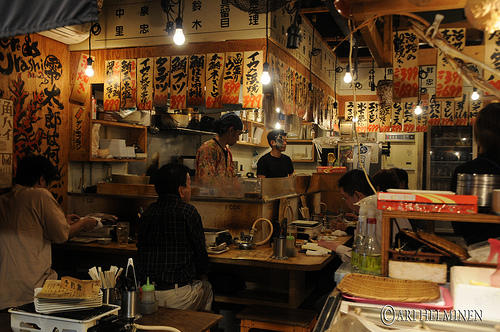Lesson 3 - Vocabulary:
Eating out
(photo
by Ari Helminen used
under terms of Creative Commons license.)

The system of writing Japanese used in this course is called the Hepburn system. Pronunciation of most of the letters presents no difficulty to an American. Those letters considered difficult to pronounce will be explained in this section of the lessons.
In this lesson, you may have difficulty with the following:
1. When the letter n is the last letter in a word, it may sound somewhat like the ng in "sing." Listen:
udon
2. When double letters appear in a Japanese word, as in ohotto and ip-pai, the sound is repeated. Think of double letters as having a hyphen between them and pronounce both letters distinctly. Listen:
|
chot-to |
mat-te |
ip-pai |
ip-pon |
3.
The
letters marked with
a bar, ā, ē, ī, and ō, are pronounced
longer than those
without a bar. Listen:
|
hambāgā |
karē |
bīru |
kōhī |
4. When
i
and u are
written with a
slash mark through them,
they are slurred,
or barely pronounced.
Listen:
|
h |
f |
S |
miruk |
5. The
letter g in
the middle of
a word is
pronounced like the ng
in "sing" by
natives of Tokyo.
Listen:
|
arigatō
|
o-negai
shimas |
The g in hambāgā, however, is not pronounced ng by natives of Tokyo because the word is borrowed from the English word "hamburger."
|
hambāgā |
hamburger |
|
karē
rais |
curried
rice |
|
yakisoba |
chow
mein |
|
subuta |
sweet-and-sour
pork |
|
gyōza |
meat
dumplings |
|
s |
sukiyaki |
|
ebi
no tempura
|
shrimp
tempura |
|
tempura
udon |
(shrimp)
tempura (in soup
with) noodles |
|
tonkats |
pork
cutlet |
|
sashimi |
sliced
raw fish
|
|
kōhī |
coffee |
|
miruk |
milk |
|
kōra |
Coke
(literally, cola)
|
|
mizu |
water |
|
o-cha |
hot
tea |
|
ais |
iced
tea |
|
bīru
|
beer |
|
sake |
sake |
|
sumimasen |
excuse
me |
|
to
īmas |
(it)
is called
|
|
to
īmas |
is
it called?
|
|
nan |
what |
|
nan
to īmas |
what
is it called? |
|
kore
nan to īmas |
what
is this one
called? |
|
des |
is;
am; are
|
|
des |
is
it? |
|
kore des |
(is
it) this one? |
|
hai |
yes;
yes, sir; yes,
ma'am |
|
hai, dōzo |
here
you are
|
|
īe
|
no |
|
īya
|
no |
|
īe, kore
des |
no,
this one
|
|
kore subuta to
īmas |
this
one's called sweet-and-sour pork |
|
kore tonkats |
this
one is a
pork cutlet
|
|
nan ni shimashō ka?
|
what
will you have?
|
|
kudasai |
please |
|
gyoza kudasai
|
meat
dumplings, please
|
|
chotto |
a
bit; say!
|
|
chotto matte kudasai |
just
a minute, please |
|
arimas |
we
do; we have. |
|
arimasen |
we
don't; we don't
have. |
|
arimas |
do
you have?
|
|
ebi no tempura
arimas |
do
you have shrimp
tempura? |
|
(hai,) arimas |
yes,
we do
|
|
(iya,) arimasen
|
no,
we don't
|
|
h |
one |
|
f |
two |
|
s |
two
orders of sukiyaki,
please |
|
ip-pai |
one
glass; one cup |
|
ip-pon |
one
bottle |
|
ni-hai |
two
glasses; two cups |
|
ni-hon |
two
bottles |
|
mizu ni-hai kudasai |
two
glasses of water,
please |
|
mō
|
more;
another |
|
bīru mō
ip-pon kudasai
|
another
bottle of beer,
please |
|
kanjō
o-negai shimas |
may I have
the check?
|
|
dōmo arigatō
gozaimash |
thank
you |
|
dōmo |
thank
you |